
96
HNUE JOURNAL OF SCIENCE
Natural Sciences 2024, Volume 69, Issue 3, pp. 96-104
This paper is available online at http://hnuejs.edu.vn/ns
DOI: 10.18173/2354-1059.2024-0039
EVALUATION OF THE ROLE OF REACTIVE OXYGEN SPECIES IN PMC-
BASED OXIDATION SYSTEMS FOR RB21 DYE DEGRADATION
Vu Thi Tinh and Nguyen Thi Bich Viet*
Faculty of Chemistry, Hanoi National University of Education, Hanoi city, Vietnam
*Corresponding author: Nguyen Thi Bich Viet, e-mail: vietntb@hnue.edu.vn
Received October 5, 2024. Revised October 24, 2024. Accepted October 31, 2024.
Abstract. This work aimed to evaluate the contribution of reactive oxygen species
(ROS) in a green oxidation system based on peroxymonocarbonate (PMC) to the
degradation efficiency of RB21 textile dye using ROS scavengers such as t-butanol,
terephthalic acid (TA), N,N-dimethylaniline (DMA), ascorbic acid. The results
showed that in reaction conditions including RB21 dye 4.63
10-2 mM (50 mg/L);
HCO3
– 50 mM; H2O2 100 mM; Co2+ 1.70
10-3 mM (0.1 mg/L), the
RB21degradation efficiency reached 90% after 180 minutes of which the
contribution percentage of CO3
•– radicals was the most important, 98.2%, while •OH
and other ROS hardly contributed to the degradation process of RB21 dye.
Moreover, the kinetic study results on the reaction between CO3
•– and its scavenger,
DMA, as well as between •OH and its scavenger, TA, indicated that the
concentrations of CO3
⦁- and •OH in the PMC system composed of HCO3
– 50 mM,
H2O2 100 mM, and Co2+ 1.70
10-3 mM were 2.35.10-13 M and 1.50.10-16 M, respectively.
Keywords: RB21 dye, PMC, reactive oxygen species, scavengers.
1. Introduction
In recent years, advanced oxidation processes (AOPs) based on
peroxymonocarbonate (PMC) have been proven to be remarkably effective in treating
harmful organic substances such as phenol [1], methyl orange (MO), rhodamine B (RhB) [2],
acid orange 7 (AO7) [3], or acid orange 8 (AO8) [4], methylene blue (MB) [5], reactive
blue (RB21) [6], reactive blue 19 (RB19) [7] with short treating times and completely
mineralized products. Compared to other advanced oxidation systems like Fenton
(Fe2+/H2O2), H2O2/O3, H2O2/UV, and O3/UV, the PMC systems, typically formed in situ
by the cobalt(II)-catalyzed reaction between bicarbonate and hydrogen peroxide, produce
more reactive oxygen species (ROS) including PMC (HCO4
‒), carbonate anion radical
(CO3
⦁-), singlet oxygen (1O2), superoxide (O2
⦁-), hydroxyl (•OH), and hydroperoxyl (•HO2)
radicals. Unfortunately, these ROS are responsible for the degradation of pollutants in
AOPs. Therefore, it is vital to understand the formation of ROS in the PMC systems and

Evaluation of the role of reactive oxygen species in PMC-based oxidation systems…
97
their contributions to pollutant degradation efficiency. For this purpose, one of the
possible approaches is using quenching agents, so-called radical scavengers [8], such as
t-butanol (•OH scavengers) [9], terephthalic acid (•OH scavenger) [10], N,N-
dimethylaniline (CO3
⦁- scavenger) [11], ascorbic acid (scavenger of most radicals) [12].
Among them, terephthalic acid (TA), a non-fluorescent compound, was reported to react
selectively with •OH with a rate constant of 4.4x109 M-1 s-1 to produce
hydroxylterephthalic acid (hTA), a fluorescent product, suitable for a photometric
determination [10]. Whereas, N,N-dimethylaniline (DMA), a fluorescent substance, was
reported to be a selective probe for CO3
⦁- radical that generates a non-fluorescent product [11].
The literature review has indicated that the dominant reactive oxygen species
produced in the PMC systems depended on the composition of the systems and the
pollutants being treated. It was reported that CO3
⦁- radicals played a key role in the
degradation of AO8 (T. Zhao et al.) [4], whereas •OH radicals played a decisive role in
treating MB (A. Xu et al.) [5]. However, another study on MB degradation by A. Xu et
al. showed that in a transition-metal-free PMC system (without Co2+), O2
⦁- might play this
key role [2]. Although these findings are interesting, information on the concentration of
these reactive species in the PMC systems is essential to clarify the organic compound
degradation mechanism of the PMC systems, however to date, no literature has been
found on ROS quantification in advanced oxidation systems like PMC.
In our previous study on RB21 textile dye degradation by PMC systems, it was
interesting to notice that the dye treatment efficiency could reach > 90% within 180
minutes and even much shorter (30 minutes) when using UV irradiation [6]. Yet neither
the role of ROS in the RB21 degradation nor their quantification has been investigated.
To address the above unresolved issues, the present work focuses on (i) determining
the contribution percentage of each reactive species to the degradation efficiency of RB21,
and (ii) quantifying two major reactive species in the PMC system, CO3
⦁- and •OH radicals.
2. Content
2.1. Experiments
2.1.1. Chemicals and instruments
All chemicals used in this work such as sodium bicarbonate, hydrogen peroxide,
cobalt nitrate, t-butanol, N,N-dimethylaniline, terephthalic acid, ascorbic acid, and
reactive blue 21 were of analytical grade and purchased from Sigma Aldrich.
A Genesys 30 Visible spectrophotometer (Thermo Scientific) and an FL8500
Fluorescence spectrophotometer (Perkin Elmer) were used to monitor the absorbance and
the fluorescence emission of the reaction solutions, respectively.
2.1.2. Investigation of RB21 degradation by PMC oxidation system in the absence
and presence of ROS quenchers
All RB21 degradation experiments were carried out in a 250-mL reactor under
magnetic stirring at 25 ± 1 oC with common reaction conditions including NaHCO3 50
mM; H2O2 100 mM; Co2+ 1.7
10-3 mM; pH ~9 (inherently buffered); RB21 dye 4.63
10-2 mM
(50 mg/L). The addition of corresponding scavengers (Entries 2 ÷ 9) was conducted
before adding RB21 dye. Other experiment conditions were specified in Table 1.

Vu TT & Nguyen TBV
98
To monitor the variation of RB21 concentration over time, after a time t, about 3 mL of
the reaction mixture was withdrawn to measure the absorbance at 625 nm. The dye
concentration at different reaction times was obtained from the 625-nm absorbance of the
dye solution according to the following equation: A625nm = (1.83 ± 0.07).10-5.CRB21 (mM)
with R2 = 0.9999, LOD = 9.91
10-4 mM, LOQ = 2.97
10-3 mM with a linear range from
1.85
10-3 mM to 0.0926 mM. The RB21 degradation efficiency (H%) was calculated
using the formula
0
0
% 100
t
CC
HC
−
=
where Co and Ct are the initial concentration and
the concentration at time t of RB21, respectively.
Table 1. Experiment conditions to investigate the contribution percentage of each
ROS to the RB21 degradation efficiency
Entry #
Experiment
ROS scavenger (CM)
1
Comparison system
Absence of scavenger
2 ÷ 3
Presence of •OH scavenger
t-butanol (0.01; 0.50 M)
4 ÷ 6
Presence of CO3
⦁- scavenger
DMA (0.0825; 0.4126; 1.6503 mM)
7 ÷ 9
Presence of most ROS scavenger
Ascorbic acid (1; 5; 10 mM)
2.1.3. Kinetic study of ROS quenching experiments
All experiments were carried out in a 100-mL reactor under magnetic stirring at 25 ± 1 oC.
The composition of the PMC system consists of HCO3– 50 mM; H2O2 100 mM; Co2+
1.70
10-3 mM. Based on preliminary studies, TA was used as •OH scavenger and its
concentration was fixed at 9.90
10-2 mM. DMA was used as CO3
⦁- scavenger and its
concentration was fixed at 0.66 mM. After a time t, about 0.5 mL of the reaction mixture
was taken out to measure the fluorescence emission. The conditions of quenching
experiments are shown in Table 2.
Table 2. Quenching experiments conditions for kinetic study
Entry #
Experiment
Scavenger
Fluorophore
Measurement condition
1
Determination
of •OH radicals
TA 9.90
10-2 mM
hTA
λex = 315 nm, λem = 425
nm, slit width 5 nm,
source energy 550V
2
Determination
of CO3
⦁- radicals
DMA 0.66
mM
DMA
λex = 298 nm, λem = 360
nm, slit width 5 nm,
source energy 400V
2.2. Results and discussion
2.2.1. Evaluating the contribution of ROS in the PMC system to RB21 degradation
To determine the contribution percentage of each reactive species, RB21 degradation
efficiency was investigated in the absence and presence of corresponding scavengers. The
experimental procedure was modified based on the literature [7]. The general principle to
evaluate the contribution of a reactive species present in the PMC system to RB21
degradation is to compare the dye degradation efficiencies in the absence of scavengers
(The comparison system) and in the presence of the scavenger of corresponding ROS.

Evaluation of the role of reactive oxygen species in PMC-based oxidation systems…
99
For this purpose, a first-order kinetic model was applied to the degradation reaction
of RB21 dye to determine the contribution of ROS in the PMC system such as •OH, CO3
⦁-,
and other reactive species. The application of the kinetic model in each quenching
experiment is described as follows:
• In the absence of scavengers:
0
[ 21] [ 21]
d RB k RB
dt
− =
• In the presence of t-butanol (•OH scavenger):
01
[ 21] [ 21]
d RB k RB
dt
− =
• In the presence of DMA (CO3
⦁- scavenger):
02
[ 21] [ 21]
d RB k RB
dt
− =
• In the presence of ascorbic acid (scavenger of most ROS):
03
[ 21] [ 21]
d RB k RB
dt
− =
where k0, k01, k02, and k03 are the observed first-order rate constants of the RB21
degradation reaction in the absence and presence of t-butanol, DMA, and ascorbic acid,
respectively.
The contribution percentage of reactive species can be calculated using the
corresponding formula in Table 3.
Table 3. Formula to calculate the contribution percentage of ROS in the PMC system
to RB21 degradation efficiency
% contribution of
•OH
CO3
⦁-
most ROS
Formula
0 01
0
kk
k
−
0 02
0
kk
k
−
0 03
0
kk
k
−
* Contribution of •OH in the PMC system to RB21 degradation efficiency
The results of •OH quenching experiments using t-butanol as the •OH scavenger are
presented in Figure 1.
Figure 1(a) indicates that the presence of t-butanol at low or high concentrations (0.01
or 0.50 M) hardly affected the RB21 degradation efficacy of the PMC system. In all cases,
the RB21degradation efficiency reached about 90% after 180 minutes. The plots in Figure
1(b) allow determining the contribution percentage of •OH as 0% because both the rate
constant of the RB21 degradation reaction in the absence and in the presence of t-butanol
was equal to 0.017 s-1 (k0 = k01). It can be concluded that in the degradation process of
RB21 by the PMC system, the role of •OH radical was negligible. This result is consistent
with the study of AO7 degradation by Y. Li et al. [3] and AO8 degradation by T. Zhao et al. [4].

Vu TT & Nguyen TBV
100
Figure 1. Kinetic investigation of RB21 degradation at different concentrations of t-
butanol: (a) RB21 degradation efficiency and (b) ln(Ct/C0) over time
* Contribution of CO3
⦁
- in the PMC system to RB21 degradation efficiency
The results of CO3
⦁- quenching experiments using DMA as the CO3
⦁- scavenger are
presented in Figure 2.
Figure 2. Kinetic investigation of RB21 degradation at different concentrations
of DMA: (a) RB21 degradation efficiency and (b) ln(Ct/C0) over time
Figure 2(a) shows that an increase in DMA concentration from 0.0825 to 1.6503 M
resulted in a dramatic diminution of RB21 degradation efficiency. Compared to the
comparison system (without scavenger), after 180 minutes of reaction, the RB21
degradation efficiency decreased from 90% to 7.3%. Figure 2 (b) reveals that the rate
constant of the RB21 degradation reaction at 1.6503 M of DMA was 0.0003 s-1 (k02) while
the one of the comparison system was 0.017 s-1 (k0), therefore the contribution percentage
of CO3
⦁- radicals calculated was 98.2% according to the formula in Table 3. This result
revealed that the CO3
⦁- radicals played a key role in the degradation of RB21 by the PMC
system. This finding is consistent with the study of T. Zhao et al. [4].
* Contribution of other reactive species in the PMC system to RB21 degradation
efficiency
It can be deduced from the results obtained that the contribution of other reactive
species in the PMC system to the degradation of RB21 was insignificant, less than 2%.
This finding was confirmed by the results obtained with the quenching experiment using
(a)
(b)
(a)
(b)

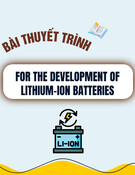
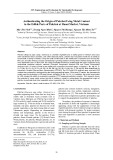
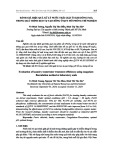
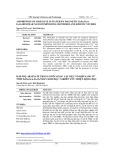
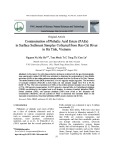
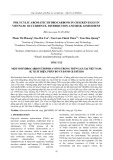
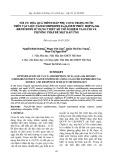

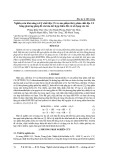
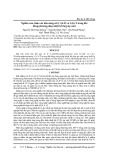

![Tài liệu Vi sinh vật môi trường [Mới nhất]](https://cdn.tailieu.vn/images/document/thumbnail/2025/20251123/ngkimxuyen/135x160/21891763953413.jpg)
![Sổ tay truyền thông Phân loại chất thải rắn sinh hoạt trên địa bàn tỉnh Quảng Nam [Chuẩn nhất]](https://cdn.tailieu.vn/images/document/thumbnail/2025/20251114/kimphuong1001/135x160/1701763094001.jpg)


![Quản lý chất thải nguy hại: Sổ tay Môi trường [Chuẩn nhất]](https://cdn.tailieu.vn/images/document/thumbnail/2025/20251029/kimphuong1001/135x160/9011761720170.jpg)









